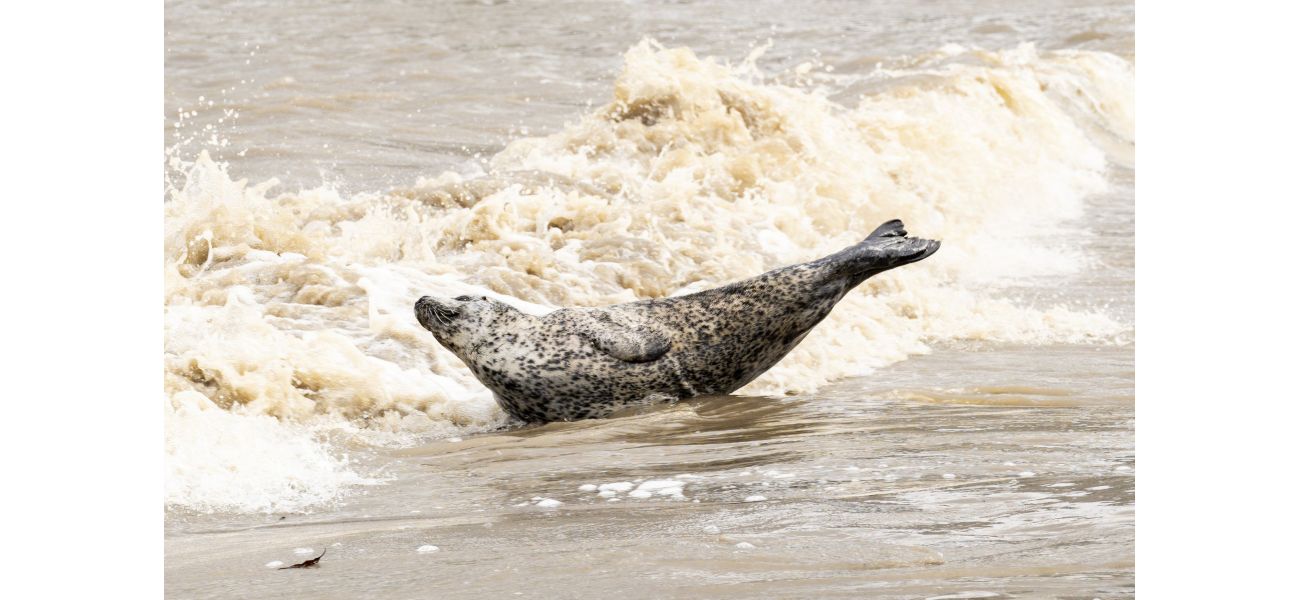A seal was seen basking in the sun in the heart of London.
The once 'dead' river from 1957 is now full of life.
October 19th 2024.

On a bustling Saturday in central London, a delightful sight caught the attention of passersby near Canary Wharf – a seal sunbathing on the banks of the Thames. With its distinctive black and white speckled fur, the playful animal was seen frolicking in the small waves of the river, providing a welcome surprise to those who happened to witness it.
While it is not uncommon for both grey seals and harbour seals to be spotted in the Thames, it is always a special treat when they decide to bask in the sun. In fact, the Zoological Society of London reported last month that there are approximately 600 harbour seals and 3,000 grey seals residing in the Thames Estuary. Some of these curious creatures even venture further up the river towards central London.
Hannah McCormick of ZSL shared with BBC the importance of protecting these native species, stating, "Seals are playful but shy creatures, so using a long-range lens to take photos from a distance allows us to accurately count them without causing any disturbance. This helps us gain a better understanding of how these animals are faring in the Thames and highlights the significance of preserving this ecosystem."
It is quite remarkable to see how much life has returned to the Thames, especially considering that it was once declared "biologically dead" in 1957. But now, the river is thriving with over 115 species of fish, 92 species of birds, and almost 600 hectares of saltmarsh. This crucial wildlife habitat is also home to some unexpected marine life, such as Tope, Starry Smoothhound, and Spurdog sharks, who use the shallow bays and estuaries as a nursery for their young.
But it's not just sharks that call the Thames home – seahorses also share the estuary with them. These odd-looking creatures may have small ranges, but they can be found there all year round. And while pie and mash, along with jellied eels, used to sustain dockers and their families in the East End, these snake-like fish are now once again a common sight in the waters of the Thames.
In addition to these unique creatures, the outer estuary is also home to wild native oysters. Not only do they provide food and reefs for young fish, but they also play a crucial role in filtering the water. Alison Debney of ZSL emphasizes the importance of estuaries as a vital ecosystem, stating, "They provide us with clean water, protection from flooding, and act as a nursery for fish and other wildlife. The Thames estuary, along with its associated 'blue carbon' habitats, is crucial in our efforts to combat climate change and create a sustainable future for both nature and people."
As we reflect on the journey of the Thames from being biologically dead to now teeming with life, we can see the progress that has been made. And with the help of organizations like ZSL, we can continue to monitor and protect this valuable ecosystem for generations to come.
While it is not uncommon for both grey seals and harbour seals to be spotted in the Thames, it is always a special treat when they decide to bask in the sun. In fact, the Zoological Society of London reported last month that there are approximately 600 harbour seals and 3,000 grey seals residing in the Thames Estuary. Some of these curious creatures even venture further up the river towards central London.
Hannah McCormick of ZSL shared with BBC the importance of protecting these native species, stating, "Seals are playful but shy creatures, so using a long-range lens to take photos from a distance allows us to accurately count them without causing any disturbance. This helps us gain a better understanding of how these animals are faring in the Thames and highlights the significance of preserving this ecosystem."
It is quite remarkable to see how much life has returned to the Thames, especially considering that it was once declared "biologically dead" in 1957. But now, the river is thriving with over 115 species of fish, 92 species of birds, and almost 600 hectares of saltmarsh. This crucial wildlife habitat is also home to some unexpected marine life, such as Tope, Starry Smoothhound, and Spurdog sharks, who use the shallow bays and estuaries as a nursery for their young.
But it's not just sharks that call the Thames home – seahorses also share the estuary with them. These odd-looking creatures may have small ranges, but they can be found there all year round. And while pie and mash, along with jellied eels, used to sustain dockers and their families in the East End, these snake-like fish are now once again a common sight in the waters of the Thames.
In addition to these unique creatures, the outer estuary is also home to wild native oysters. Not only do they provide food and reefs for young fish, but they also play a crucial role in filtering the water. Alison Debney of ZSL emphasizes the importance of estuaries as a vital ecosystem, stating, "They provide us with clean water, protection from flooding, and act as a nursery for fish and other wildlife. The Thames estuary, along with its associated 'blue carbon' habitats, is crucial in our efforts to combat climate change and create a sustainable future for both nature and people."
As we reflect on the journey of the Thames from being biologically dead to now teeming with life, we can see the progress that has been made. And with the help of organizations like ZSL, we can continue to monitor and protect this valuable ecosystem for generations to come.
[This article has been trending online recently and has been generated with AI. Your feed is customized.]
[Generative AI is experimental.]
0
0
Submit Comment





